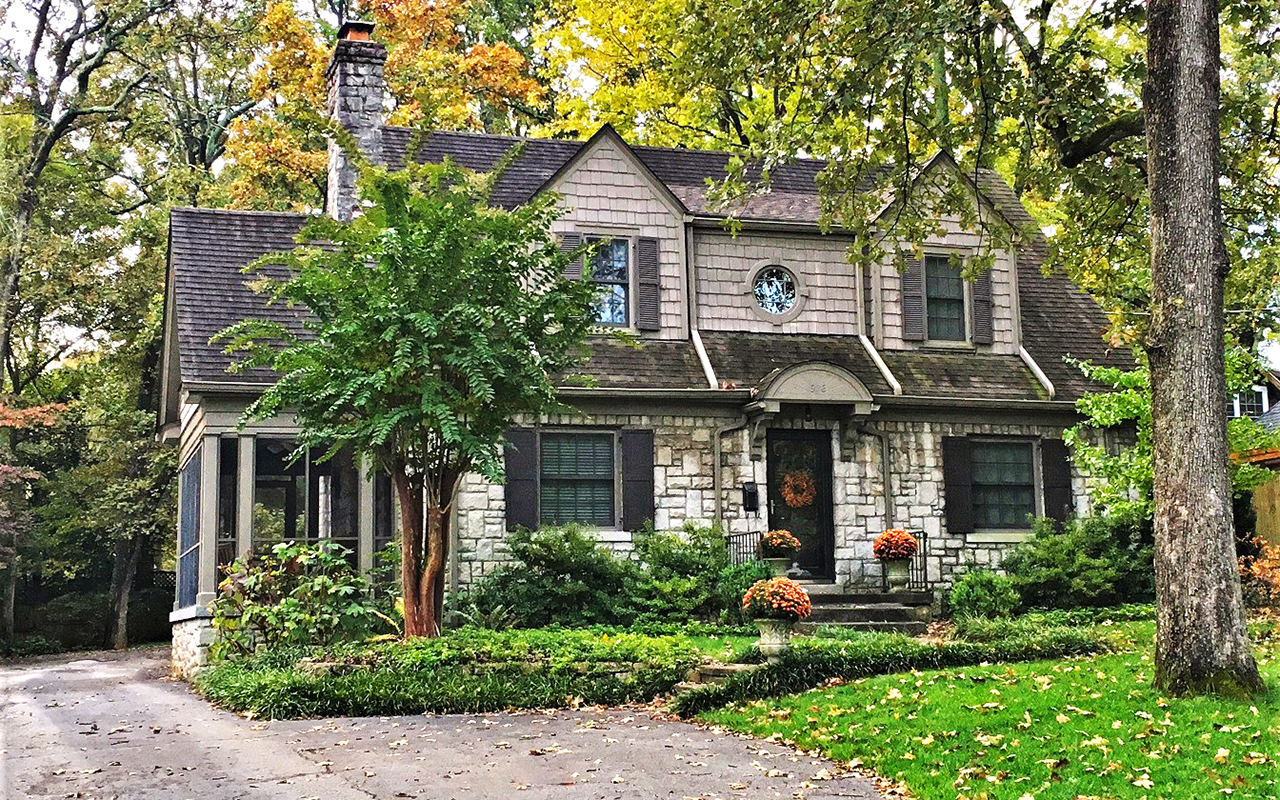Bowling Green City
Bowling Green City Hall is located at 1001 College Street, Bowling Green, KY 42102.
Phone: 270‑393‑3000.

Photo: L.K. Causey House, circa 1939, located at 936 Covington Street. Listed on the National Register of Historic Places in 2015. Built from a design by James Maurice Ingram, a prolific Bowling Green architect. Photographed by User: Jon Roanhaus own work), 2017, [cc-4.0], via Wikimedia Commons, accessed August, 2021.
Beginnings [1]
Situated in a bowl of hills in a bend of the Barren River, Bowling Green was established and designated the county seat of government in 1798. Robert Moore, who donated two acres of his land to the county for the erection of the public buildings, had arrived in Warren County in the early 1790s and had built a log house near a spring at what is now the northeast corner of State and Main Streets. The "Big Spring" was dedicated to public use in 1799. During the first decades of the nineteenth century, Bowling Green grew principally around the public square, westward along Main Street, and along the two main north-south streets running beside the public square College and State Streets. All of the structures from the earliest period have been destroyed, three houses remaining seem to have been built in the 1820s and a number of Greek Revival structures have survived. These substantial, well executed Greek buildings represent the first period of commercial prosperity that resulted from slack water navigation improvements in the Green and Barren Rivers in the 1830s and 1840s.
Neighborhoods
A second period of prosperity due to the arrival of the Louisville and Nashville Railroad in 1859 was postponed by the Civil War. The damage of the Civil War years in part explains the scarcity of pre-1840 structures. Although the majority of Warren County residents preferred neutrality in the War, Bowling Green was occupied by armies of both sides. The L & N Railroad intersected the Confederate line of defense almost at its center, with the Tennessee capital at one terminus and W. T. Sherman's army at the other. To discourage a Federal approach over the railroad, General Johns ton sent 4,000 soldiers under Simon Bolivar Buckner to occupy Bowling Green. Losses in the West made the Confederate position at Bowling Green untenable, and on 14 February 1862 Buckner's army withdrew as the Union forces advanced. The Confederates set fire to the rail depot and warehouses near the courthouse square, while the Union army bombarded the center of the city to hasten the withdrawal of the Confederates. As a result the courthouse and many buildings facing the square were burned.
The courthouse and other county buildings were rebuilt on Tenth Street, one block south of the public ground, and the public square was subsequently turned over the city for use as a park. Much of Bowling Green's stock of commercial and residential buildings was completed in the four decades that followed the Civil War. The single most popular architectural style in these years was the Italianate, but mixtures of various styles predominated all of the relatively pure styles combined. These decades were also marked by speedy improvements in urban amenities. The town's first water system was complete by 1868, Fountain Square Park was dedicated in 1872, by 1876 the city of 6,000 was gas lighted, and the first street car rails were laid on Main Street in 1889. It was also in this period that Bowling Green's black population coalesced in the area between Seventh Street and the Barren River, in northern Bowling Green.
Following the Civil War Bowling Green became a regional leader in education. In 1876 there were three schools for women and one college for men. Ogden College, an institution for both men and women endowed by Robert W. Ogden, opened in 1877. City public schools were organized under a special state charter and opened in 1883. In 1884 the Southern Normal School for the training of teachers was moved to Bowling Green, in 1886 the Bowling Green Business University was founded, and in 1889 Potter College, a Christian nonsectarian college for women, opened. In 1906 the Southern Normal School and the Bowling Green Business University were combined to form a new state school, the Western Kentucky State Normal School, and two years later the state bought Potter College and moved the school to the Potter College campus on College Heights.
In general terms the city of Bowling Green may be described by reference to two axes. The north-south axis on State and College Streets includes the principal northern approaches to the city at the Barren River, landmarks in the predominantly black section, several Federal style brick structures adjacent to the business district, Fountain Square Park and surrounding business structures, the principal governmental structures, numerous late nineteenth and early twentieth century residences in the College Hill District and along College Street and the campus of Western Kentucky State University on the summit of College Hill. The east-west axis extends along Main Street from Reservoir Hill in the east the present site of the city's hospital and the former site of one of the Civil War forts that ringed the city through the Upper East Main Street District, the Downtown Commercial District, across the L & N Railroad tracks to include a significant Federal style brick house and an important industrial structure and into the St. Joseph's District.
- Dr. Kenneth T. Gibbs, architectural historian, Jayne C. Henderson, historian, and Lee D. Walker, historian, Kentucky Heritage Commission, Warren County Multiple Resource Area, Warren County, Kentucky, nomination document, 1978, National Park Service, National Register of Historic Places, Washington, D.C.
Nearby Towns: Plum Springs City •
